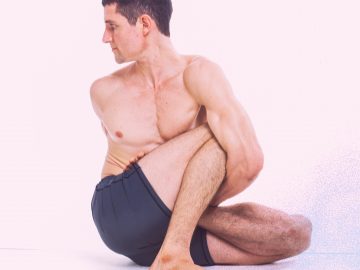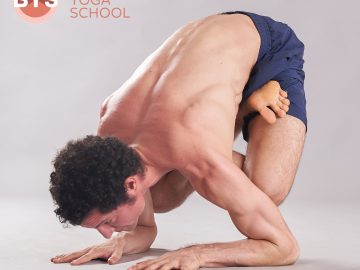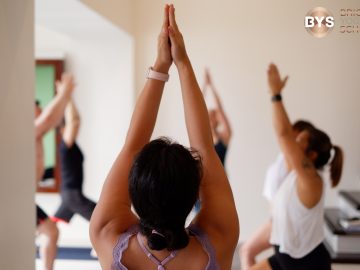Along with jumping back, jumping through is one of the most common movements you will encounter when practicing the seated postures in the Ashtanga Vinyasa Primary Series.
When practiced properly, jumping back/through will help your body do the following:
- Create internal heat
- Clear up the energetic movement generated in the previous asana. As every asana moves energy through the nadis (energy channels throughout the body), jumping back and jumping through helps clear the nadis to make space for the next asana to move energy through them as well
- Release tension from the deltoids (the muscles at the tops of the shoulders)
- Release the lower back
- Strengthen the core muscles. Having a strong core is essential as you practice the deeper backbends of the Second Series
- Build the foundation for more complex arm balances, which you will eventually encounter in the Second Series and Advanced Series
- Keep your spine balanced. Since most of the seated postures in the Primary Series are asymmetrical, jumping back/through will help realign the spine
When practicing jumping through with straight legs, it is advisable to begin doing it from Marichyasana D on the left side onward. All the postures after this deep twist are symmetrical, so jumping through with straight legs will save energy and time, which will help you to eventually practice following the right number of vinyasas in the traditional Ashtanga Vinyasa method.
The difference between jumping through with crossed legs and with straight legs lies in the flexibility of your hamstrings – jumping through with straight legs requires flexibility in this area. How flexible do you need to be? Let’s find out by doing these simple steps:
1. Sit down with your legs extended straight in front of you
2. Begin to fold forward without using your hands to pull yourself down
3. Move your belly as close as possible to the thighs, and then extend your arms forward
If your hands and at least a quarter of your forearm can pass beyond the soles of your feet, this means that you have enough flexibility to jump through with straight legs. If you still need to work on your hamstring flexibilty, and would like to practice jumping through with crossed legs for now, you can find out more information about that movement here: http://www.itsyogasatellite.com/2015/02/08/how-to-jump-through-using-your-body-and-your-breathing/
If you can perform the previous exercise with no problem, but are still finding jumping through with straight legs a bit challenging, here are some techniques to help you flow through this movement with more ease:
- As soon as your feet lift off from the ground (as you hop up from Downward Facing Dog), keep the knees slightly bent, and press your thighs close to your chest as if you are trying to do Paschimottanasana in the air
- To start off, don’t lift your hips up too high; focus more on moving the hips in a horizontal line
- Your drishti (gazing point) should be forward, perhaps 1 foot in front of your hands. This is subtle, yet very helpful technique to direct the movement forward
- Keep the shoulders forward, in front of the line of the wrists
- Keep the feet flexed and toes actively spread throughout the movement
- Squeeze the inner thighs together
- Actively push the hands down to create more space between your feet and the ground
Finally, if you are able to move your legs through, as you lightly lower down to sit, remember to always keep your shoulders in front of your wrists, and your hips should always stay behind the wrists.
We know it is a lot of information to absorb all at once, and some of them are difficult to imagine. To help you understand all of these tips better, follow this link to see how all these tips create a flow of movements: https://youtu.be/WaeKnTwgaHo
If you have any questions or concerns with regard to this topic or any aspect of your yoga practice, feel free to contact us at info@brightyoga.com. We will be more than happy to help you. Enjoy your practice!
Namaste,
Bright Yoga Team



